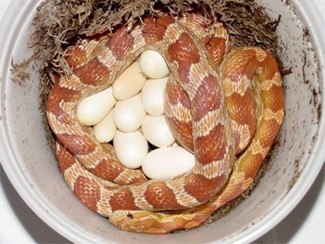
Dr. Laurie Hess is our resident exotics expert and contributes regularly on the Pet Health Network. For more from Dr. Hess, find her on Facebook!
While it is more common for egg-laying animals to follow seasonal cues to breed, such as longer day length, warmer temperatures, and more plentiful food sources, pet birds and reptiles don’t always follow these rules. Pets are generally maintained under unchanging temperature and light conditions in our homes and usually have the same access to food regardless of the time of year. Thus, pet birds and reptiles sometimes lay eggs during the non-breeding season, unlike their wild counterparts.
Since many pet birds and reptiles lay eggs all year round, these animals have the potential to develop reproductive problems all year round, some of which can be life threatening. One of the most common problems I encounter as a veterinarian who solely treats birds and other exotic pets, like reptiles, is egg binding. Egg binding is a catch-all term for failure of the animal to lay an egg. The egg is retained within the female’s body typically somewhere within the reproductive tract (except ectopic eggs that come out of her reproductive tract but are still retained within her body - a very difficult situation that is usually treatable only with surgery). The egg may be retained in its fully developed form, with a yolk and egg white inside and a shell outside, or it may get stuck in the reproductive tract at any stage of earlier development. Egg binding can happen in birds and reptiles from lack of essential nutrients (especially lack of calcium which is critical in forming the egg’s outer shell), lack of ultraviolet light (that helps form active vitamin D in birds’ and reptiles’ skin to enable them to absorb calcium from food), excessively large or malformed eggs that are either too big or misshapen to pass through and out of the reproductive tract, or physical problems within the reproductive tract (such as a twist in the oviduct – the tube that connects the ovary to the cloaca, the chamber where eggs exit the body).
Each of these different causes of egg binding is treated differently. To help the animal lay, some egg-bound pets merely require supportive care, such as fluids underneath the skin to rehydrate them if they haven’t been eating, a calcium injection if they haven’t been getting adequate calcium in their diet, or supplemental vitamin D if they have not been exposed to direct ultraviolet light. In more complicated cases, such as when there is a physical obstruction within the oviduct, preventing the egg from passing, the egg may need to be surgically removed – a procedure that can involve great risk and frequently great expense due to the often difficult nature of the surgery.
Since egg binding can be life threatening, bird and exotic pet owners must do everything they can to try to prevent this condition from happening. Both birds and reptiles need to be fed complete diets containing all the nutrients in the proper proportions to meet the additional demands that egg laying plays on the body. Since different species of birds and reptiles have different nutritional requirements, owners of these pets should consult with bird and reptile-savvy veterinarians to get the most up-to-date recommendations regarding feeding. Birds and most reptiles also require direct UV light, unfiltered by window glass, to produce adequate vitamin D. Birds should not be encouraged to lay; they should not be given access to small places (like closets or cabinets or underneath beds) where they can build nests. Owners should touch birds only on their heads, not on their bodies, so that they don’t send confusing quasi-sexual messages to their pets, and they should remove all mirrored toys from their birds’ cages so as not to make the birds think that they have mates.
Unlike with birds, with reptiles, interaction with and behavioral cues from owners plays less of a part in determining whether to lay eggs, and it is harder to deter egg-laying in reptiles than it is in birds. If a reptile starts to show signs of egg-laying (swollen body, decreased appetite, burrowing), they should be given a place with appropriate nesting material to dig and lay. In addition, they should be kept at species-specific optimal temperatures, so that if they decide to lay, conditions are perfect for them to do so.
Egg-laying is a natural behavior that both birds and reptiles everywhere demonstrate. Owners of these animals should not be afraid if their pets display egg-laying behavior. The trick is for owners to educate themselves about their pets’ needs, both during non-breeding times and during these animals’ reproductive cycles, to try to prevent egg-binding from developing if egg-laying occurs.
If you have any questions or concerns, you should always visit or call your veterinarian – they are your best resource to ensure the health and well-being of your pets.
The opinions and views expressed in this post are those of the author's and do not necessarily represent the beliefs, policies or positions of PetHealthNetwork.com, IDEXX Laboratories, Inc. or its affiliates and partner companies.
